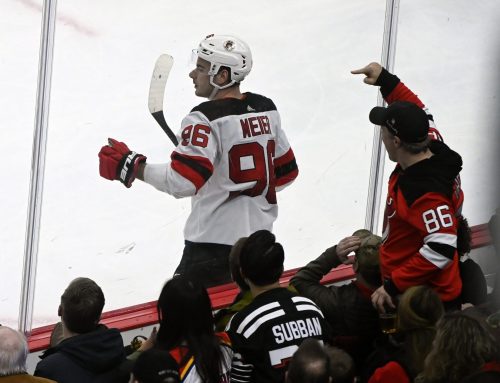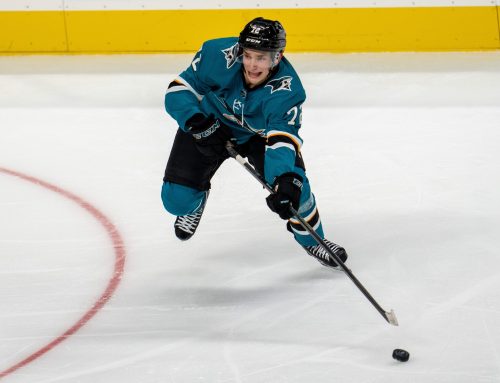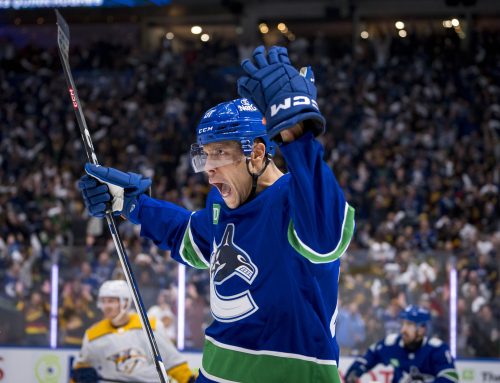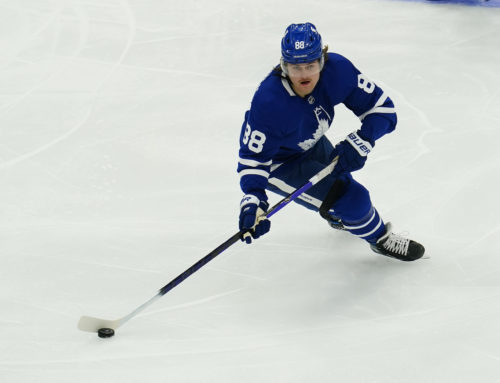Ramblings: Roos Digs Deep on Scoring Rates After a Long Break, Deeper Stats, Goalies on the Cusp and More
Rick Roos
2020-07-14
Greetings Dobberites! I tried to figure out the last time I pinch-hit to do a Ramblings, and couldn't remember, which means it's been quite a while. Hopefully I live up to the lofty standards of the normal ramblers…..
Although during these trying times it's even worse than usual to be aging, part of the benefits of me turning 50 (!) this Sunday is I've now been involved in fantasy hockey half my life. Why is that relevant? It means I was "there" for the shortened seasons in 1994-95 and 2012-13.
How does that have any bearing on the here and now? Although most of the focus in fantasy hockey at present is rightfully on the 24 teams playing hockey this summer once the NHL resumes, there will still be seven teams who'll ultimately have gone ten months – and maybe longer before all is said and done – without any NHL action. And that, to me, will be analogous to what happened in 1994-95 and 2012-13, when all NHL teams went an extra almost four months between when the previous season ended and the puck dropped again.
As such, I figured I'd look at data from not just 1994-95 and 2012-13, but also the seasons immediately prior to each. From that, I can try and predict what might happen to these seven non-playoff teams next season. In other words, by reviewing past team comparables, we can try to get a sense of how the Sabres, Ducks, Senators, Sharks, Kings, Red Wings, and Devils – and their players – might fare once they take the ice again after having not played for roughly as long as squads were idle due to these two lockouts. I realize that such analysis of season to season team data is far from perfect in that it doesn't take into account factors (such as player ages, injuries, trades, signings) that might have affected a team's performance one season to the next; but it's still data which I think can be useful to assess.
I was going to look at 2003-04 and 2005-06 too; but in the end I decided that what amounted to well more than a year with no hockey being played wasn't comparable enough to what is likely to occur here, as these other two seasons, both of which had hockey resume in January – i.e., the objective for 2020-21 – were more analogous. And yes, I realize the plan is to play an 82 game season for 2020-21, versus only 48 games in 1994-95 and 2012-13; nevertheless, I still think there's something to be learned. With all that out of the way, let's get to the numbers.
In 1993-94, the seven worst teams based on total points (and by points I mean in the standings, not goals scored) were the Senators, Jets, Whalers (ah, memories…..), Oilers, Kings, Lightning and the then Mighty Ducks, in that order (i.e., the Sens had the lowest point total, and the Ducks and Lightning were tied for the highest). Here's some data for each team during 1993-94, as well as the same data for the 1994-95 season, which started on January 20, 1995 and consisted of each team playing 48 games, versus the 84 (yes, that was the set number back then) played by each team in 1993-94. Also provided is the league average for all NHL teams for both seasons.
| 1993-94 Goals scored per game | 1994-95 Goals Scored per game | 1993-94 PP% | 1994-95 PP% | 1993-94 SV% | 1994-95 SV% | ||||||
| Senators | 2.39 | 2.43 | 14.48% | 14.42% | 0.857 | 0.889 | |||||
| Jets | 2.91 | 3.27 | 19.39% | 19.18% | 0.877 | 0.885 | |||||
| Whalers | 2.70 | 2.64 | 14.95% | 17.24% | 0.889 | 0.904 | |||||
| Oilers | 3.10 | 2.83 | 18.41% | 16.22% | 0.895 | 0.875 | |||||
| Kings | 3.50 | 3.62 | 20.72% | 17.50% | 0.894 | 0.896 | |||||
| Lightning | 2.66 | 2.50 | 14.69% | 14.12% | 0.891 | 0.891 | |||||
| Ducks | 2.72 | 2.60 | 14.36% | 11.39% | 0.904 | 0.897 | |||||
| League Average | 3.24 | 2.98 | 18.64% | 17.73% | 0.893 | 0.898 | |||||
So three teams saw an improvement in goals scored, which is notable since the league as a whole saw its scoring drop by a pretty decent amount. And it wasn't just a case of there being nowhere to go but up, since the Jets and Kings both had a healthy goal total to begin with. Just one team – the third worst Whalers – fared better in PP% in 1994-95 compared to 1993-94, although we can see that trend was in keeping with a drop league-wide in that area. In terms of SV%, numbers were better or essentially unchanged for all but two of the teams, which also was not inconsistent with an improvement for all league teams on average.
In 2011-12, the seven worst teams (again, based on standings points and in order from worst to "best") were the Blue Jackets, Oilers, Canadiens, Islanders, Ducks, Leafs and Wild. Here is the same data for each of those teams – plus the league averages – for 2011-12 and then 2012-13, which, like 1994-95 was a 48 game shortened season and in this case started on January 19, 2013.
| 2011-12 Goals scored per game | 2012-013 Goals scored per game | 2011-12 PP% | 2012-13 PP% | 2011-12 SV% | 2012-13 SV% | |
| Blue Jackets | 2.41 | 2.39 | 15.46% | 14.19% | 0.899 | 0.920 |
| Oilers | 2.52 | 2.56 | 20.61% | 18.22% | 0.908 | 0.917 |
| Canadiens | 2.52 | 3.04 | 14.29% | 20.69% | 0.912 | 0.904 |
| Islanders | 2.39 | 2.81 | 18.52% | 19.87% | 0.898 | 0.899 |
| Ducks | 2.45 | 2.79 | 16.61% | 21.48% | 0.905 | 0.914 |
| Leafs | 2.77 | 3.02 | 18.35% | 18.67% | 0.898 | 0.917 |
| Wild | 2.02 | 2.46 | 15.12% | 17.88% | 0.916 | 0.904 |
| League Average | 2.65 | 2.64 | 17.31% | 18.22% | 0.911 | 0.909 |
What stands out is how little change there was year-to-year in league averages. For goals scored, all seven were either virtually unchanged or saw improvement. It was a somewhat similar story for PP%, although in that case the two worst teams saw a decrease. Save percentage dropped by a tad league-wide; but four (i.e., more than half) of these teams saw marked improvement, while two had a decrease that was well worse than the league average.
Overall, these weakest teams seemed to improve as much if not more so than the league-wide average and/or didn't get worse when the league-wide average did. Am I surprised? No, as bad teams tend to be young or old; and in both cases, a longer time off would seem to be beneficial to mature (young) or heal/rejuvenate (old). So I'm likely to be more prone to upgrading players on the Sabres, Ducks, Sens, Sharks, Kings, Wings, and Devils for 2020-21. Do I expect big improvement? No; but based on this data maybe their players might do so better than otherwise predicted.
********
Shifting gears to the upcoming 2020 playoffs, I expect the most impact fantasy-wise will be with respect to goalies. There's already been rumblings that teams might not reflexively go with who was considered the #1 (or 1A) goalie during the season, and instead let Phase 2/3 determine the netminder who gets the nod.
Given this, who do I think are most vulnerable? Mainly guys who weren't clear-cut #1s by the time the season ended, like, off the top of my head, Philipp Grubauer, David Rittich, Petr Mrazek, Pekka Rinne, Mikko Koskinen, Elvis Merzlikins, and Devan Dubnyk. That's a lot of names! I'd even add guys like Semyon Varlamov and Ben Bishop, although in both their cases it shouldn't have a spillover effect into 2020-21 due to their contract sizes. For the others I named though, there could be repercussions into 2020-21; and if you're in a league that allows trading right now, I might consider dealing one or more of those I named if you think they're vulnerable to getting passed on the depth chart by a hot playoff goalie.
********
Most times I've done Ramblings in the past I liked to try to look for hidden meaning behind certain stats. Today I'll focus on SOG. Of course the belief is the more SOG a player has the better, not just because it's often its own category in leagues, but also due to the perception that more SOGs means more goals.
Interestingly though, of 29 forwards who fired 200+ SOG this season, five had fewer than 20 goals, nine had 20-29, ten had 30-39, and the remaining five potted 40+. So five among the top 29 had more than double the goals as the same number within the top 29. I found that surprising, and I think it's worth doing some digging to try and determine an explanation.
The five who had 40+ finished with 311, 290, 218 and 208 SOG, versus 245, 232, 223, 209, and 207 for those with fewer than 20. So three who failed to record 20+ goals had more shots that two of the five who had 40+. Not surprising, but also not in and of itself responsible for such a big gap in goals between the groups.
Given this data, it doesn't take a rocket scientist to discern that an explanation rest in shooting percentage. After all, the shooting percentages of those with 40+ goals ranged from 15.4 to 19.7 percent, whereas those with fewer than 20 goals had a range of 6.9 to 8.7 percent. Double the percentages of the five with fewer than 20 goals, and voila, suddenly things are essentially even.
But was there more to it than that? Let's dig deeper to find out.
Looking at the number of shots taken, which is SOG plus shots that were either blocked or missed the net, the five who had 40+ goals had totals of 602, 507, 504 (all within the top five overall), 402 (11th), and 350, while those with fewer than 20 goals had 395, 387, 385, 363 and 349. So all but one of those who had under 20 goals attempted fewer shots than all five of those who had 40+ goals despite all ten being above 200+ SOG.
What about shot quality? Did it matter? The five with 40+ goals had 50, 61, 58, 69 and 71 SOG from 0 to 15 feet from the net. For perspective, 71 ranked only tied for 14th most. Those who had fewer than 20 goals though had 57, 44, 62, 48 and 43. So as was the case with shots taken, all but four of the 40+ goal scorers had more SOG from 0-15 feet than all but one of those with fewer than 20 goals.
Lastly, let's look at SOG with the man advantage. The five 40+ goal scorers tallied 92, 80, 76, 62 and 60. For perspective, 92 led the entire NHL among forwards, and 80 and 76 were within the top ten. The five with fewer than 20 goals had 59, 66, 42, 47 and 46. So here yet again, all of those with 40+ goals had higher numbers than all but one of those with fewer than 20 markers.
So although shooting percentage certainly impacted the goal totals for those who had fewer than 20 markers, they also were measurably worse than those with 40+ goals in several other metrics. Who were those with under 20 goals but 200+ SOG this season? Tyler Seguin, Taylor Hall, Dylan Larkin, Johnny Gaudreau, and Alex Debrincat. While I'd say it's safe to count on them all improving in goals per game next season, don't get your hopes up for a big rebound, as they appear to lack the telltale signs of what it takes to be a true sniper in today's NHL.
Oh, in case you're wondering where I got all this useful information. It was via the Frozen Tools Report Generator under the "Shots" category, serving as yet another reminder of how invaluable a resource Frozen Tools is!
**********
Lastly, while we're on the subject of Frozen Tools, this season there was only one team (Boston) who had a top line that skated together for more than 60 percent of even strength shifts. In some cases injuries might've led to lower percentages on some teams; but it brings up a key point in fantasy, namely that lines are less set in stone than they were even a couple of years ago. Consequently, if you draft someone based on his expected presence on a scoring line, you could hit a home run but just as easily end up very disappointed if he's bumped in favor of someone else. In other words, be worried Kailer Yamamoto and Victor Olofsson owners…….
Knowing this, what can be done when it comes to fantasy research? Focus on duos. There's an nhl.com sub-site I bookmarked a few years ago which I don't think a lot of people use, and can be accessed here. Only six different reports can be generated, but the key one to me is "Point Pairs," which lists players who both received a point on a goal scored while they were on the ice. If you restrict it to forwards, you get this data. Are there a lot of surprises? Not at the top; But, I definitely didn't realize Max Pacioretty and Mark Stone had such amazing chemistry. Same for Brayden Schenn and Jaden Schwartz, as well as Anze Kopitar and Alex Iafalo.
If you're looking for players who are likely to remain on the same line in 2020-21, this is a resource you want to use. While you're there, check on the same data for Power Play Point Pairs, as from that you can help figure out who'll likely stay on the same man advantage unit, which can be just as important.
**********
That's all I have. Hopefully you enjoyed my guest Ramblings. Be well and let's get excited for a return to actual hockey in….knock on wood….just over two weeks!





 TOR
TOR BOS
BOS DAL
DAL VGK
VGK EDM
EDM L.A
L.A COL
COL FLA
FLA T.B
T.B VAN
VAN WPG
WPG NYR
NYR MTL
MTL
